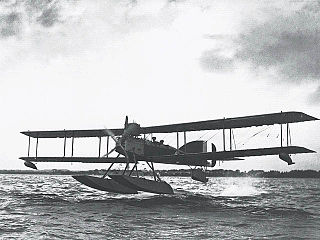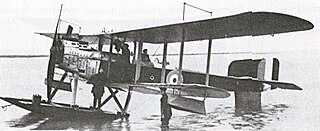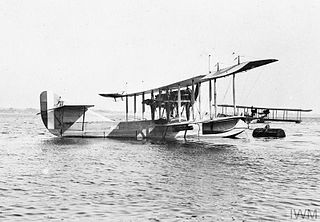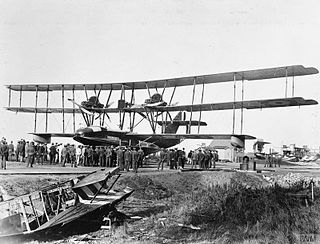
The Sopwith Camel is a British First World War single-seat biplane fighter aircraft that was introduced on the Western Front in 1917. It was developed by the Sopwith Aviation Company as a successor to the Sopwith Pup and became one of the best-known fighter aircraft of the Great War. In total, Camel pilots were credited with downing 1,294 enemy aircraft, more than their counterparts flying any other Allied fighter of the conflict. Towards the end of the war, the type also saw use as a ground-attack aircraft, partly because the capabilities of fighter aircraft on both sides had advanced rapidly and left the Camel somewhat outclassed.

The Sopwith Pup is a British single-seater biplane fighter aircraft built by the Sopwith Aviation Company. It entered service with the Royal Naval Air Service and the Royal Flying Corps in the autumn of 1916. With pleasant flying characteristics and good manoeuvrability, the aircraft proved very successful. The Pup was eventually outclassed by newer German fighters, but it was not completely replaced on the Western Front until the end of 1917. The remaining Pups were relegated to Home Defence and training units. The Pup's docile flying characteristics also made it ideal for use in aircraft carrier deck landing and takeoff experiments and training.

The Supermarine Stranraer is a flying boat designed and built by the British Supermarine Aviation Works company at Woolston, Southampton. It was developed during the 1930s on behalf of its principal operator, the Royal Air Force (RAF). It was the RAF's last and fastest biplane flying boat.

The Fairey Aviation Company Fairey III was a family of British reconnaissance biplanes that enjoyed a very long production and service history in both landplane and seaplane variants. First flying on 14 September 1917, examples were still in use during the Second World War.

The Blackburn Shark was a carrier-borne torpedo bomber designed and built by the British aviation manufacturer Blackburn Aircraft. It was originally known as the Blackburn T.S.R., standing for "torpedo-spotter-reconnaissance", in reference to its intended roles. The Shark was the last of Blackburn's biplane torpedo bombers.

The Hawker Woodcock was a British single-seat fighter built by the Hawker Engineering Company as the first fighter to be produced by Hawker Engineering. It was used by the RAF as a night fighter in the 1920s.

The twin-engine F5L was one of the Felixstowe F series of flying boats developed by John Cyril Porte at the Seaplane Experimental Station, Felixstowe, England, during the First World War for production in America.

The Supermarine Southampton was a flying boat of the interwar period designed and produced by the British aircraft manufacturer Supermarine. It was one of the most successful flying boats of the era.

The Felixstowe F.2 was a 1917 British flying boat class designed and developed by Lieutenant Commander John Cyril Porte RN at the naval air station, Felixstowe during the First World War adapting a larger version of his superior Felixstowe F.1 hull design married with the larger Curtiss H-12 flying boat. The Felixstowe hull had superior water contacting attributes and became a key base technology in most seaplane designs thereafter.

The Short Admiralty Type 184, often called the Short 225 after the power rating of the engine first fitted, was a British two-seat reconnaissance, bombing and torpedo carrying folding-wing seaplane designed by Horace Short of Short Brothers. It was first flown in 1915 and remained in service until after the armistice in 1918. A Short 184 was the first aircraft to sink a ship using a torpedo, and another was the only British aircraft to take part in the Battle of Jutland.

The Felixstowe Porte Baby was a British reconnaissance flying boat of the First World War, first flying in 1915.

The Felixstowe F.5 was a British First World War flying boat designed by Lieutenant Commander John Cyril Porte RN of the Seaplane Experimental Station, Felixstowe.

The Fairey Campania was a British ship-borne, patrol and reconnaissance aircraft of the First World War and Russian Civil War. It was a single-engine, two-seat biplane with twin main floats and backward-folding wings. The Campania was the first aeroplane ever designed specifically for carrier operations.

The Short S.8/8 Rangoon was a 1930s British three-engined biplane flying boat, designed and built by Short Brothers for the Royal Air Force.

The Curtiss Model H was a family of classes of early long-range flying boats, the first two of which were developed directly on commission in the United States in response to the £10,000 prize challenge issued in 1913 by the London newspaper, the Daily Mail, for the first non-stop aerial crossing of the Atlantic. As the first aircraft having transatlantic range and cargo-carrying capacity, it became the grandfather development leading to early international commercial air travel, and by extension, to the modern world of commercial aviation. The last widely produced class, the Model H-12, was retrospectively designated Model 6 by Curtiss' company in the 1930s, and various classes have variants with suffixed letters indicating differences.

The Norman Thompson N.T.4 was a twin-engined British flying boat of the First World War. Although less well known than similar Curtiss and Felixstowe flying boats, 50 were ordered for Britain's Royal Naval Air Service.

The Felixstowe F.4 Fury, also known as the Porte Super-Baby, was a large British, five-engined triplane flying-boat designed by John Cyril Porte at the Seaplane Experimental Station, Felixstowe, inspired by the Wanamaker Triplane/Curtiss Model T. At the time the Fury was the largest seaplane in the world, the largest British aircraft, and the first aircraft controlled successfully by servo-assisted means.

The Saro Cloud was a British passenger amphibian flying boat designed and built by Saunders-Roe as the A.19. It was later produced as the A.29 for the Royal Air Force for pilot and navigator training.

The Norman Thompson N.T.2B was a British single-engined flying boat trainer of the First World War. A single-engined biplane, the N.T.2B was adopted as a standard flying boat trainer by the Royal Naval Air Service, training pilots for larger patrol flying boats such as the Felixstowe F.2.

The Wanamaker Triplane or Curtiss Model T, retroactively renamed Curtiss Model 3 was a large experimental four-engined triplane patrol flying boat of World War I. It was the first four-engined aircraft built in the United States. Only a single example (No.3073) was completed. At the time, the Triplane was the largest seaplane in the world.























